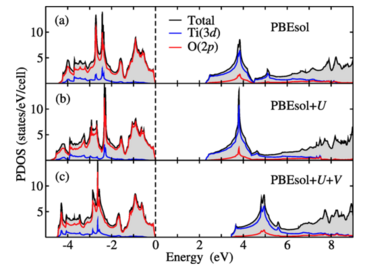G. Gebreyesus, Lorenzo Bastonero, Michele Kotiuga, Nicola Marzari, Iurii Timrov
Physical Review B 108 (2023): 235171
doi: 10.1103/PhysRevB.108.235171
We present a first-principles study of the low-temperature rhombohedral phase of BaTiO3 using Hubbard corrected density-functional theory. By employing density-functional perturbation theory, we calculate the onsite HubbardU for Ti(3d) states and the intersite HubbardV between Ti(3d) and O(2p) states. We show that applying the onsite Hubbard U correction alone to Ti(3d) states proves detrimental, as it suppresses the Ti(3d)–O(2p) hybridization and drives the system towards a cubic phase. Conversely, when both onsite U and intersite V are considered, the localized character of the Ti(3d) states is maintained, while also preserving the Ti(3d)–O(2p) hybridization, restoring the rhombohedral phase of BaTiO3. The generalized PBEsol+U+V functional yields good agreement with experimental results for the band gap and dielectric constant, while the optimized geometry is slightly less accurate compared to PBEsol. Zone-center phonon frequencies and Raman spectra are found to be significantly influenced by the underlying geometry. PBEsol and PBEsol+U+V provide satisfactory agreement with the experimental Raman spectrum when the PBEsol geometry is used, while PBEsol+U Raman spectrum diverges strongly from experimental data highlighting the adverse impact of the U correction alone in BaTiO3. Our findings underscore the promise of the extended Hubbard PBEsol+U+V functional with first-principles U and V for the investigation of other ferroelectric perovskites with mixed ionic-covalent interactions.
©2023, American Physical Society

